A complete guide to retention marketing
Published on April 21, 2025/Last edited on April 21, 2025/21 min read


Team Braze
Retention marketing keeps companies in business. After all, brands succeed when customers choose to use their products or services to meet their needs. Over and over again. When organizations fail to hang onto customers, it’s costly for the business. On the flip side, managing to retain customers over time could help brands save on customer acquisition costs (CAC) and achieve higher profits.
That’s why there’s tremendous value in building out a customer retention strategy that fosters long-term relationships and engagement. In this guide, we’ll provide you with the tools, resources, and guidance needed to do just that.
Here are the fundamentals of customer retention marketing that we’ll cover:
- What is customer retention marketing?
- Why is customer retention marketing important?
- Customer retention marketing: Why now?
- Customer retention marketing vs acquisition marketing
- Customer retention marketing campaign examples
- Acquisition marketing campaign examples
- 5 real-life examples of customer retention marketing
- How to create a best-in-class customer retention marketing strategy
- 4 ways customer engagement platforms support client retention marketing initiatives
- Final thoughts
- Top retention marketing FAQs
What is customer retention marketing?
Customer retention is when businesses are able to keep—or retain—the customers they’ve acquired actively engaging with their brand. This happens when gyms when retailers, ride-sharing services, banks, health insurance companies, beverages, quick service restaurants, food delivery apps—you name it—remain the go-to for their customers.
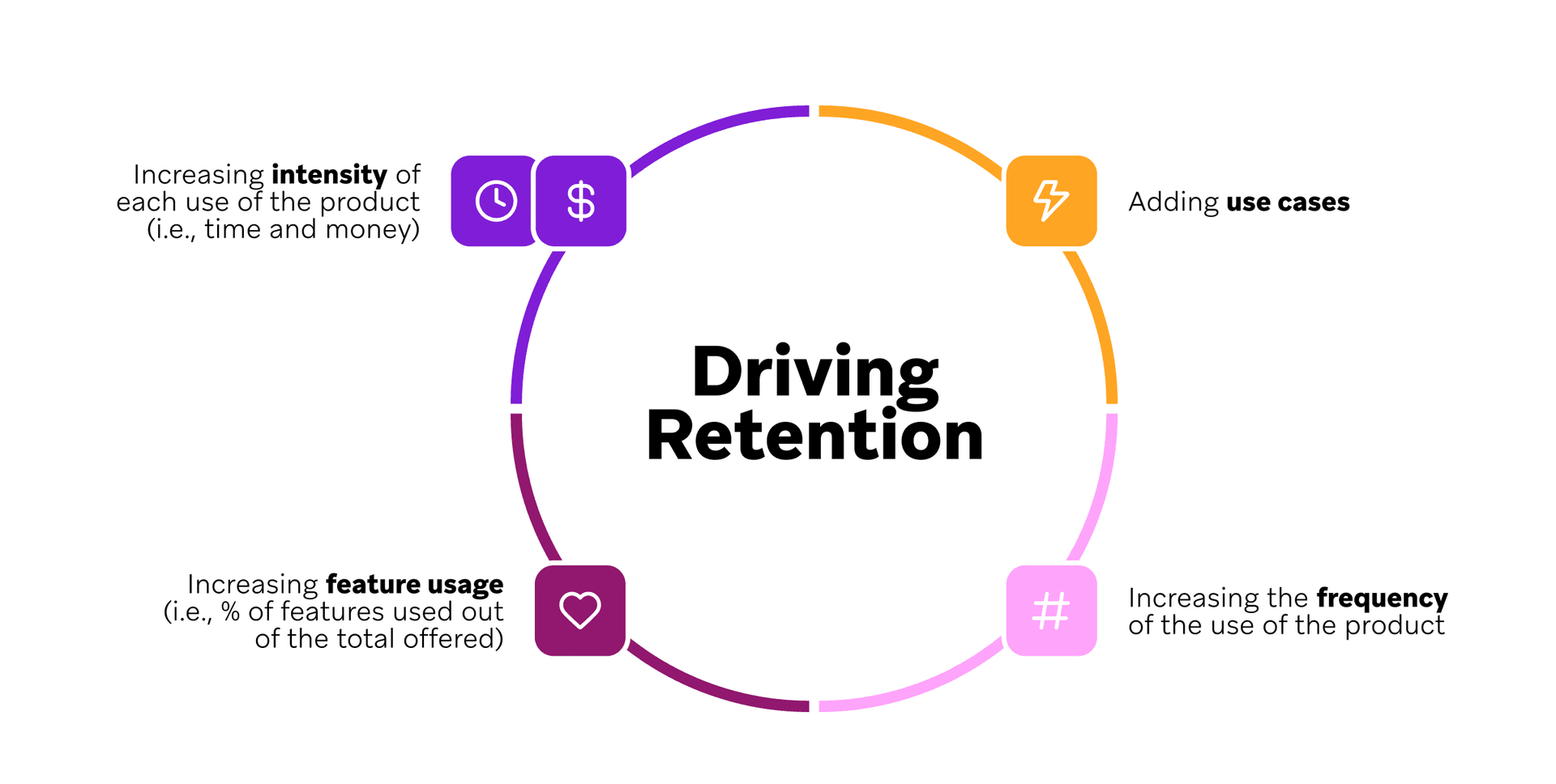
Customer retention marketing efforts help brands retain the customers they’ve already acquired and continue being a brand of choice in their category. Brands utilize customer retention marketing campaigns to get lapsing or inactive customers to re-engage. These campaigns can be deployed across channels to encourage repeat website visits, app sessions, and purchases as well as subscription and membership renewals.
When email, SMS, and push notification subscribers no longer open or click on campaigns as frequently as they once did or stop engaging altogether, these are signals of churn, and prime opportunities for brands to intervene with well-timed customer retention marketing campaigns that drive opens, clicks, and conversions.
Why is customer retention marketing important?
Customer retention marketing is important because it fosters sustainable growth for businesses and helps keep marketing costs in check. That’s because it’s more costly to acquire new customers than to get existing customers to make repeat purchases—6-7X more expensive. In addition to yielding cost savings, well-designed customer retention marketing efforts help brands boost critical KPIs, such as conversions, purchases, profits, customer lifetimes, and customer lifetime value.
The business value of customer retention marketing
1. Using cross-channel customer engagement strategies can increase retention. For example, Braze research shows that brands see an average uplift of 56% in 90-day retention for each new channel they add to their marketing mix (up to a total of six).
Research shows that it costs 6-7X more to acquire new customers than to get existing customers to make purchases. Are you doing enough to retain your customers?
2. According to some estimates, existing customers spend 67% more than new customers. They are also more likely to convert than new customers.
3. Gains in customer retention are linked to gains in customer lifetime value (CLV). As retention goes up, CLV does as well, and that’s when businesses succeed. Experts recommend achieving an CLV:CAC ratio of 3:1 to deliver the strongest financial outcomes.
4. Customer switching costs add up to trillions of dollars for businesses. When customers ditch a brand over poor service, this customer churn adds up to trillions of dollars in expenses for US companies.
Customer retention marketing: Why now?
Given today’s ongoing market uncertainty, companies can’t afford costly media investments that fail to deliver desired results. More than ever, customer retention marketing is crucial for fueling long-term business viability.
Brands cannot afford to lose valuable, current customers, making retention marketing even more important. When customer acquisition costs are greater than customer lifetime value, that’s an untenable business model.
It’s no wonder then that more and more brands are planning to increase their investment in retention marketing efforts. Research conducted for the 2025 Global Customer Engagement Review found that 42% of marketers surveyed spent more than half of their marketing on retention efforts.
Customer retention marketing vs. acquisition marketing
While the goal of customer retention marketing is to get existing customers to keep engaging with a given brand, the purpose of acquisition marketing is to help companies acquire new customers for the very first time. The two efforts are not mutually exclusive, and each plays an important role in helping companies stay in business.
Pros and cons of customer acquisition marketing efforts
Pros:
- Acquisition marketing helps companies develop a customer base when they are first getting started in business, launching new products or services, or increase incremental revenue
- Brands can harness the power of first-party data to more effectively acquire new customers who are similar to existing high-value customers
Cons:
- Ineffective paid acquisition efforts can be costly and unsustainable for businesses, and even lead to losses; one study found that companies lose $29 on average for every new customer acquired via paid digital advertising channels
- Organic customer acquisition marketing efforts can be more cost-effective, but can take time to deliver results
Acquisition can only fuel growth for so long and most companies achieve success by following the 80/20 rule, in which about 20% of customers generate about 80% of business and for some the ratio is as high as 90/10.
Pros and cons of customer retention marketing
Pros:
- Customer retention marketing helps businesses optimize spending by getting current customers to continue to engage and do business with the brand
- Retention efforts expand the lifetime value and average lifetimes of existing customers
Cons:
- Retention alone isn’t enough to keep companies in business; some customer acquisition marketing efforts are necessary to develop a customer base to begin with
- Customer retention efforts that are deployed too late in the game after customers have already churned or switched to a competitor are less likely to have the desired impact
Customer retention marketing tactics
Effective customer retention marketing campaigns help brands boost purchases and other campaign conversions, such as app and website sessions, and loyalty program engagement. Here are some sample campaign ideas to get your team’s creative juices flowing.
Customer retention marketing campaign example: Win-back campaign
Win-back campaigns can be an effective tool for increasing repeat visits and purchases among lapsing customers. These can be used across owned messaging channels, such as email, web push, mobile push, and SMS/MMS, as well as via paid retargeting advertising. Re-engaging lapsed users and bringing them back into the funnel is more cost-effective than acquiring new users.
Here’s an example of how fictional fashion brand PantsLabyrinth uses cross-channel retargeting to re-engage customers who haven’t been active in a while.
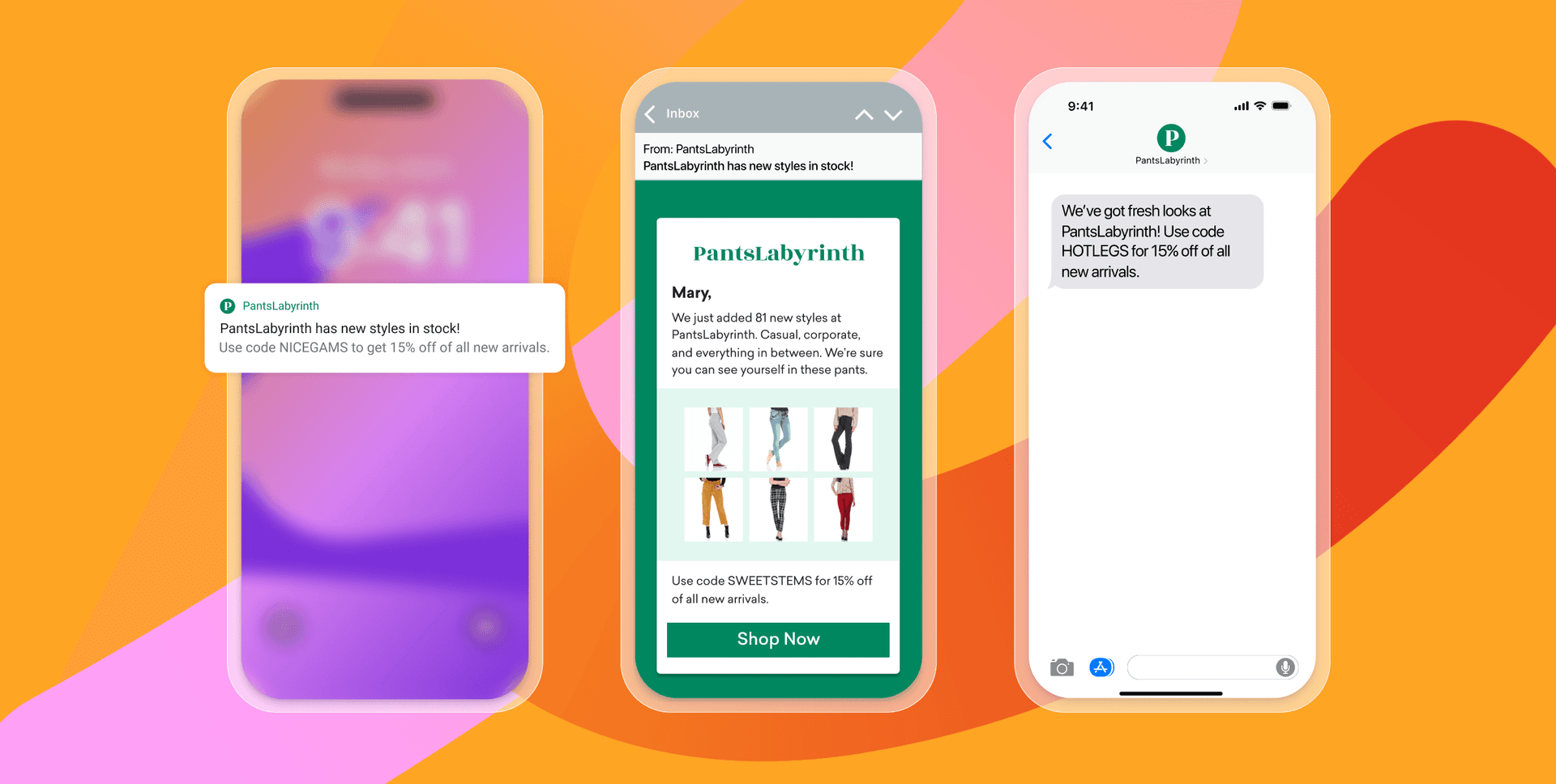
Customer retention marketing campaign example: Personalized recommendations campaign
Are customers bouncing from your website or app simply because they can’t find what they’re looking for? Using the first-party data you have about your users’ behaviors and preferences can help you surface relevant content in real-time and draw customers back to engage with your range of product or service offerings. See this in action with a fictional campaign for the imaginary streaming brand MovieCanon.
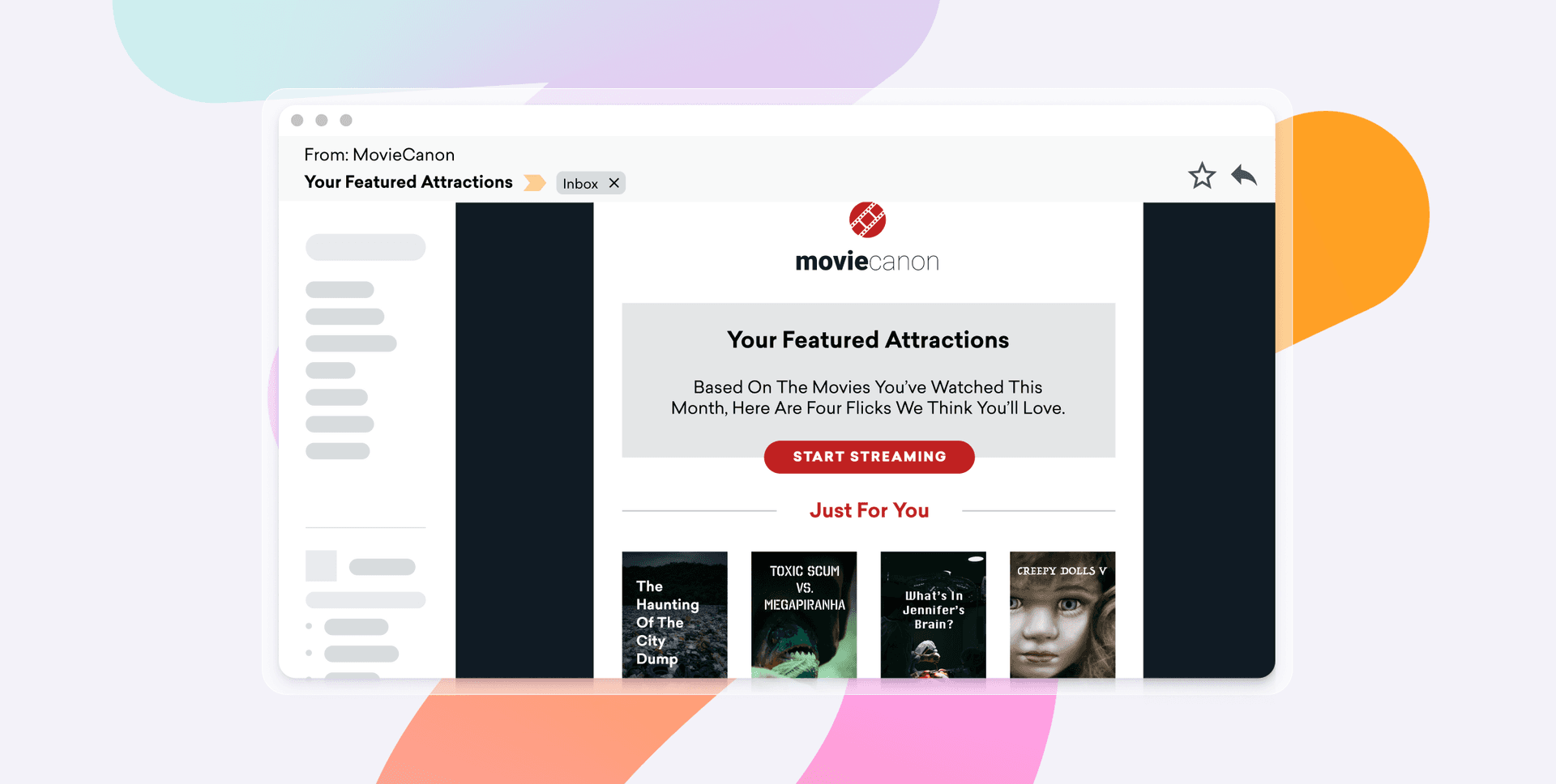
Customer Retention Marketing Campaign Example: Abandoned Intent Campaign
Each customer who abandons a task is a missed engagement and conversion opportunity. However, all doesn’t have to be lost. With abandoned intent campaigns, brands can follow up with customers based on their user-specific actions and offer value-adds, such as a discount, exclusive content, or even customer support to encourage customers to finish what they’ve started.
Check out the Braze Inspiration Guide to unlock even more customer retention marketing campaign ideas that your team can utilize across email, SMS/MMS, mobile push, in-app messages (IAMs), Content Cards, web push, in-browser messages, and social media ad campaigns to facilitate repeat website and app visits and fuel conversions.
The Braze Inspiration Guide is here to help. This collection of 50 inspirational use cases—inspired by real campaigns carried out by Braze customers—can be easily customized to fit your unique needs.
Acquisition marketing campaign examples
There’s a wide range of platforms and formats companies can use to reach and connect with customers. Here are some sample campaigns that can be used to acquire new audiences.
Acquisition marketing campaign example: Digital advertising
The following is an example of a digital advertising campaign a fictional streaming app could use across channels like social media and content websites to raise brand awareness and generate more free trial sign-ups for the company’s service.
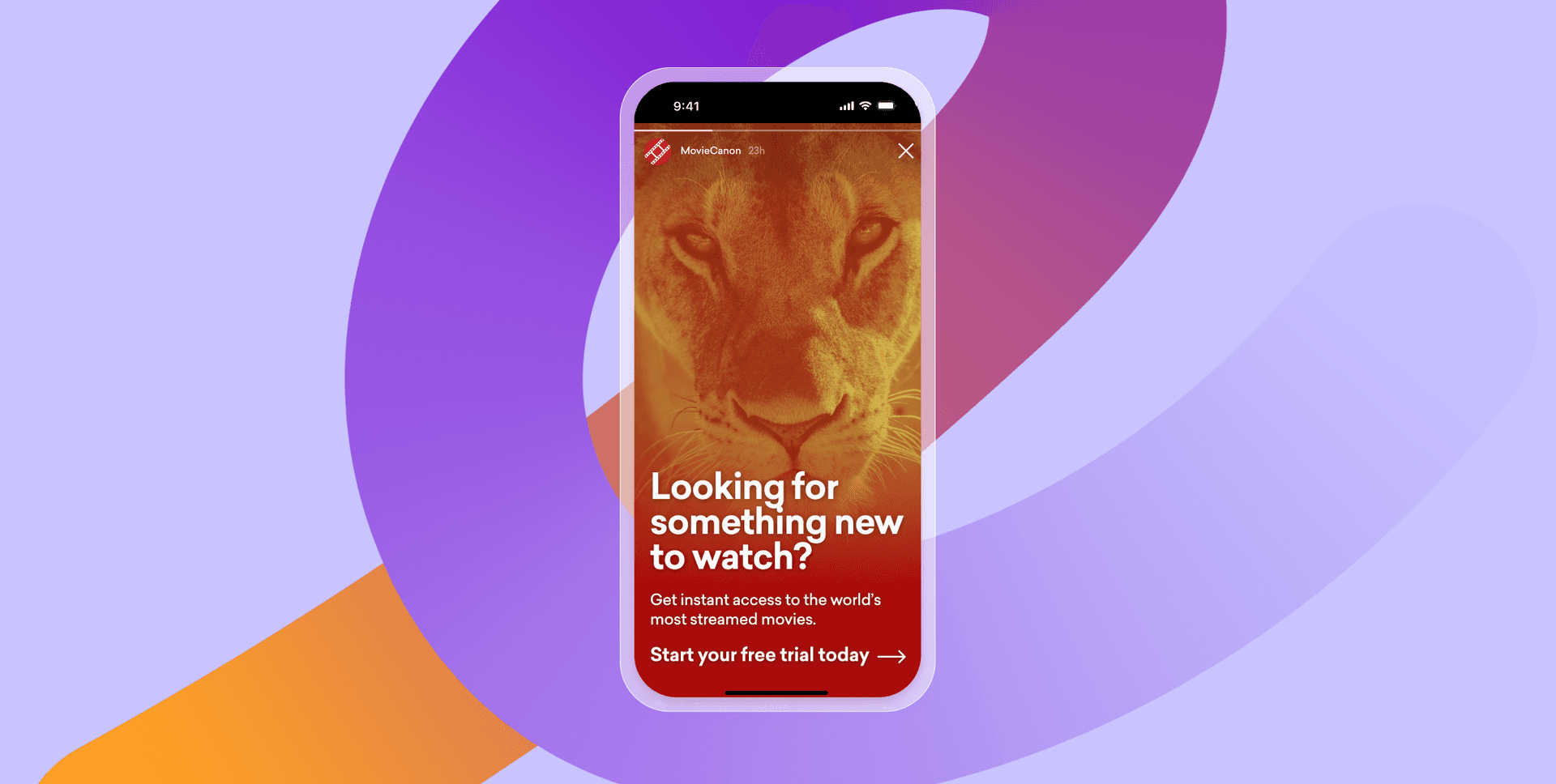
Acquisition marketing campaign example: Out of home advertising
Here’s an example of an educational ad campaign the fictitious Steppington fitness community could use to encourage new app downloads via OOH placements on public transportation and in transit hubs.
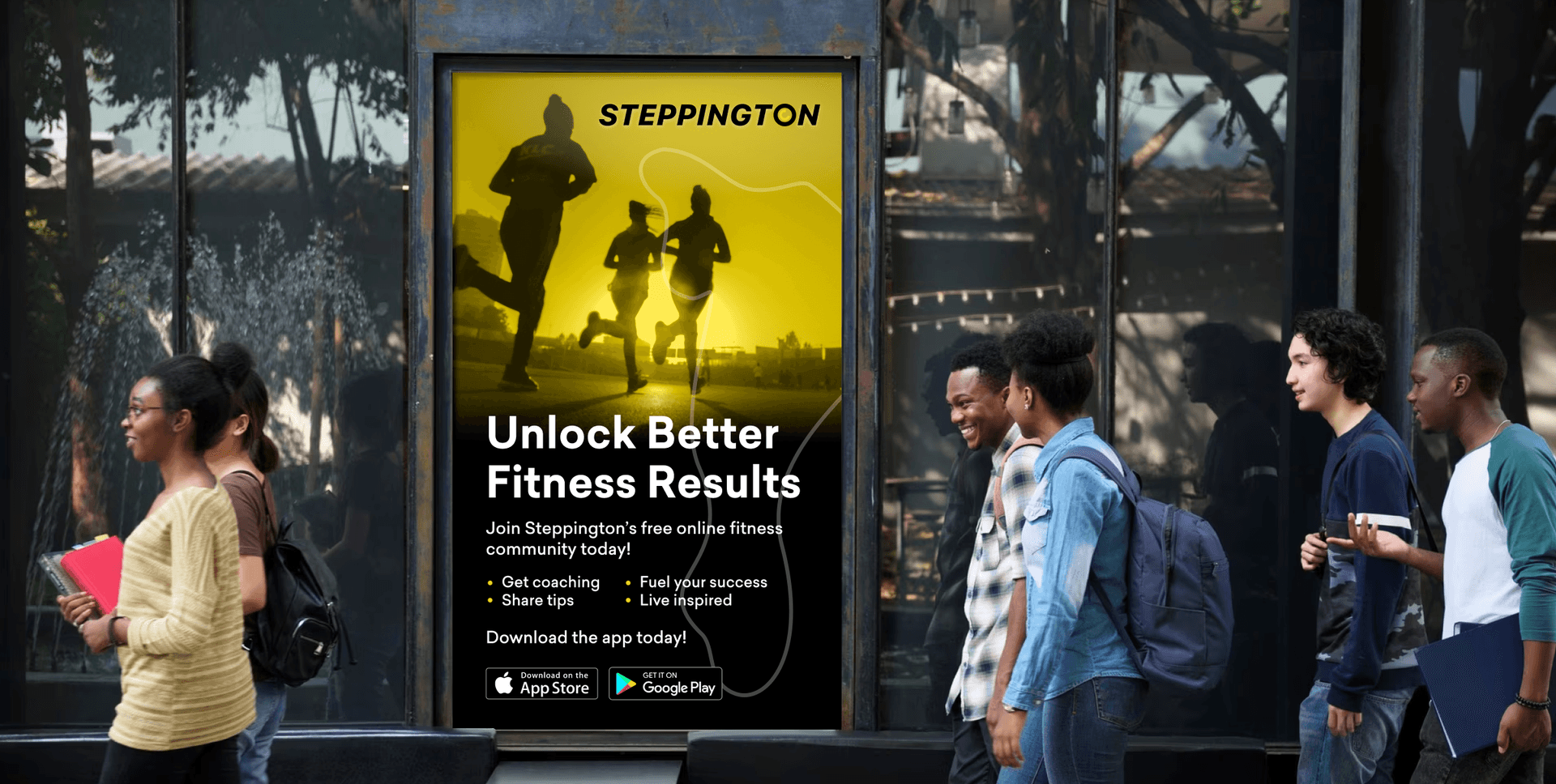
5 real-life examples of customer retention marketing strategies
From KFC to Peacock, here are five real-world examples of innovative brands using effective customer retention marketing campaigns to deliver a major impact—increasing purchases, reducing churn, and encouraging engagement over users’ lifetimes.
1. KFC India boosted customer retention with a gamified approach
With a mission to biggest, most heart-led QSR brand in the world, KFC India has over 1,000 locations and is one of the key growth markets for the global brand. Customer engagement is important to their success—more engaged customers lead to improved retention, which fuels longer lifetime value.
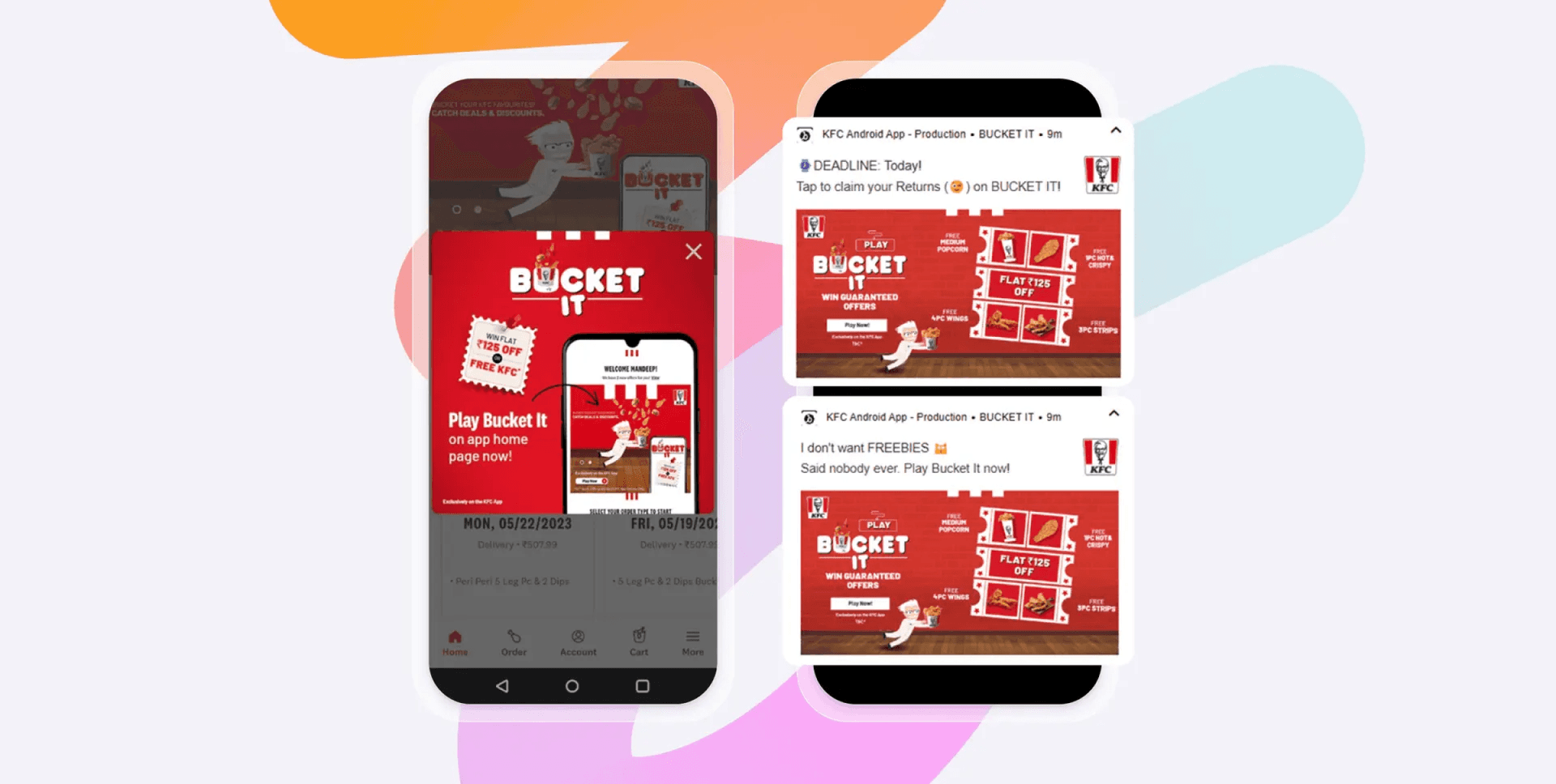
Despite its strong market presence, KFC India recognized the potential to enhance app engagement, drive purchases, and attract new customers. Building on the success of a previous gamified cricket-themed campaign, they launched the "Bucket It" game, which encourages users to play for rewards such as free menu items and discounts.
To promote the game, KFC India utilized an in-app message to redirect customers to the external game page and implemented a multi-channel approach for increased awareness and participation. This included daily push notifications and side in-app messages for users who hadn't redeemed rewards recently, biweekly emails and SMS reminders for likely engaged users, and targeted advertising through Facebook and Google.
Results:
- 22% increase in average daily orders per store
- 23% lift in daily revenue per store, 22% growth in new users
- 27% growth in repeat orders.
2. Rappi reactivates lapsed users with WhatsApp
The popular Latin American on-demand platform Rappi uses a range of channels to stay in touch with their audience—push, IAMs, email, and, the newest addition to the company’s cross-channel mix, WhatsApp. While in the past, Rappi had relied on WhatsApp for acquisition, they had a hunch WhatsApp could be a powerful channel for reaching lapsed users. When they looked into the channel’s performance by segment, the team found out that active users and lapsed users had similar read rates for WhatsApp messages, 71% and 67% respectively.
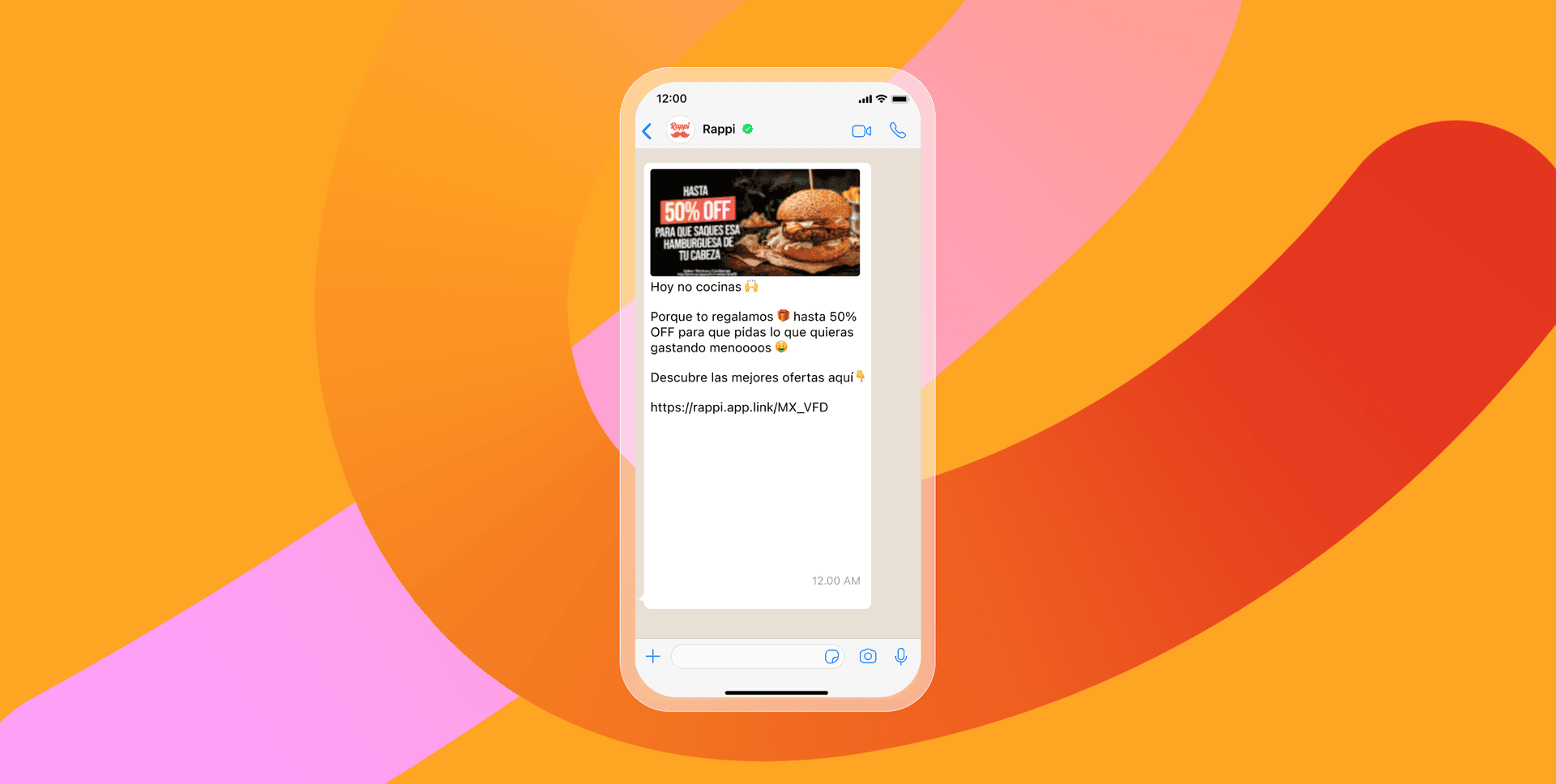
When they tested their theory out—by sending WhatsApp re-engagement campaigns in addition to push notifications and emails to lapsed users—Rappi saw incredible results, including an 80% increase in purchases among the inactive segment of users. By delivering relevant and valuable campaigns, Rappi could leverage the power of WhatsApp engagement to drive purchases and customer retention.
Results:
- 80% Increase in Users Who Made a Purchase
- 28% Lift in Users Who Reactivated and Made a Purchase Within 30 Days
- 43% Lift in Users Who Reactivated and Made 2 Purchases or More Within 30 Days
3. Peacock celebrated individual milestones to reduce churn rate by 20%
Not only are year-end recaps highly popular among users, they can be powerful tools for customer retention. That’s what streaming service Peacock found out when the team launched an impactful and personalized “What you watched this year” campaign.
Designed to commemorate subscribers’ viewing milestones, encourage free users to convert to paid subscriptions, and get customers pumped up for the coming year’s content, Peacock utilized capabilities from Braze and Braze Alloys partners mParticle and Movable Ink to showcase individual users’ engagement and the different genres and amount of content they consumed over the year.
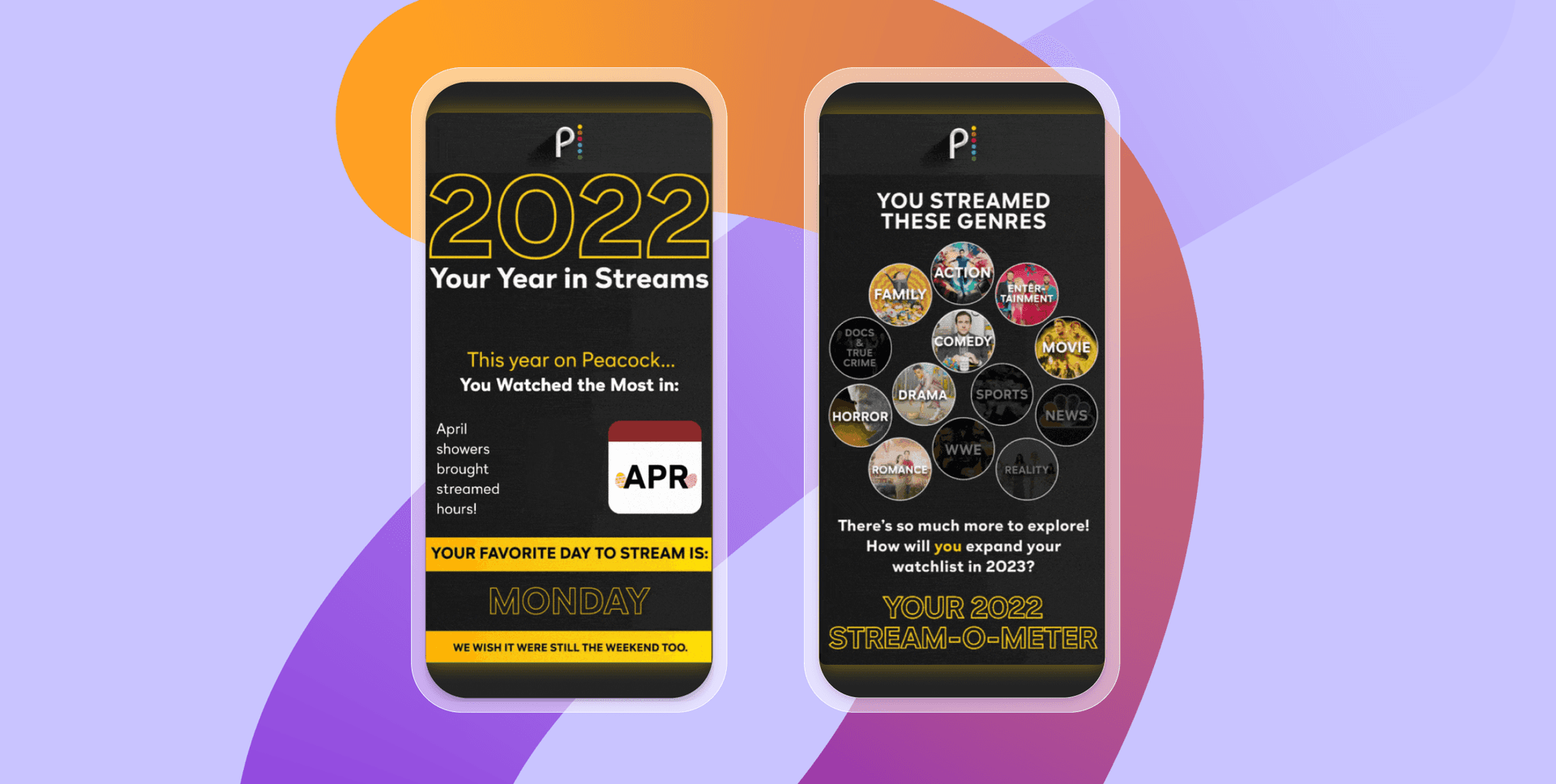
Compared to a control group of users who did not receive a year-in-review email, the group that received a recap were 20% less likely to churn within 30 days of receiving the campaign and had a 6% increase in converting from free to paid subscriptions.
Results:
- 20% Reduction in Churn Rate
- 6% Lift in Upgrades from Free to Paid Subscriptions
- +2 Return Rate to View Content
4. Tapas optimized the onboarding experience to boost new user retention by 100%
One of the fastest-growing digital publishing platforms of webcomics and novels in North America, Tapas has over 9 million monthly active users. Having experienced rapid growth over the last decade, the team wanted to better understand how new users were engaging and what they could do to measure and improve customer retention. To accomplish these goals, Tapas partnered with Braze to:
- Capture and act on user behavior insights from sign-up and throughout the user journey to personalize campaigns and reduce turnover
- Track drop-off rates during each step of the onboarding funnel and test messaging variants to improve conversions
- Automate sending “Ink” (special currency within the platform) after users complete select triggering events
Integrate learnings from Braze Alloys technology partner Amplitude to understand and act on user behavior to improve content engagement rates
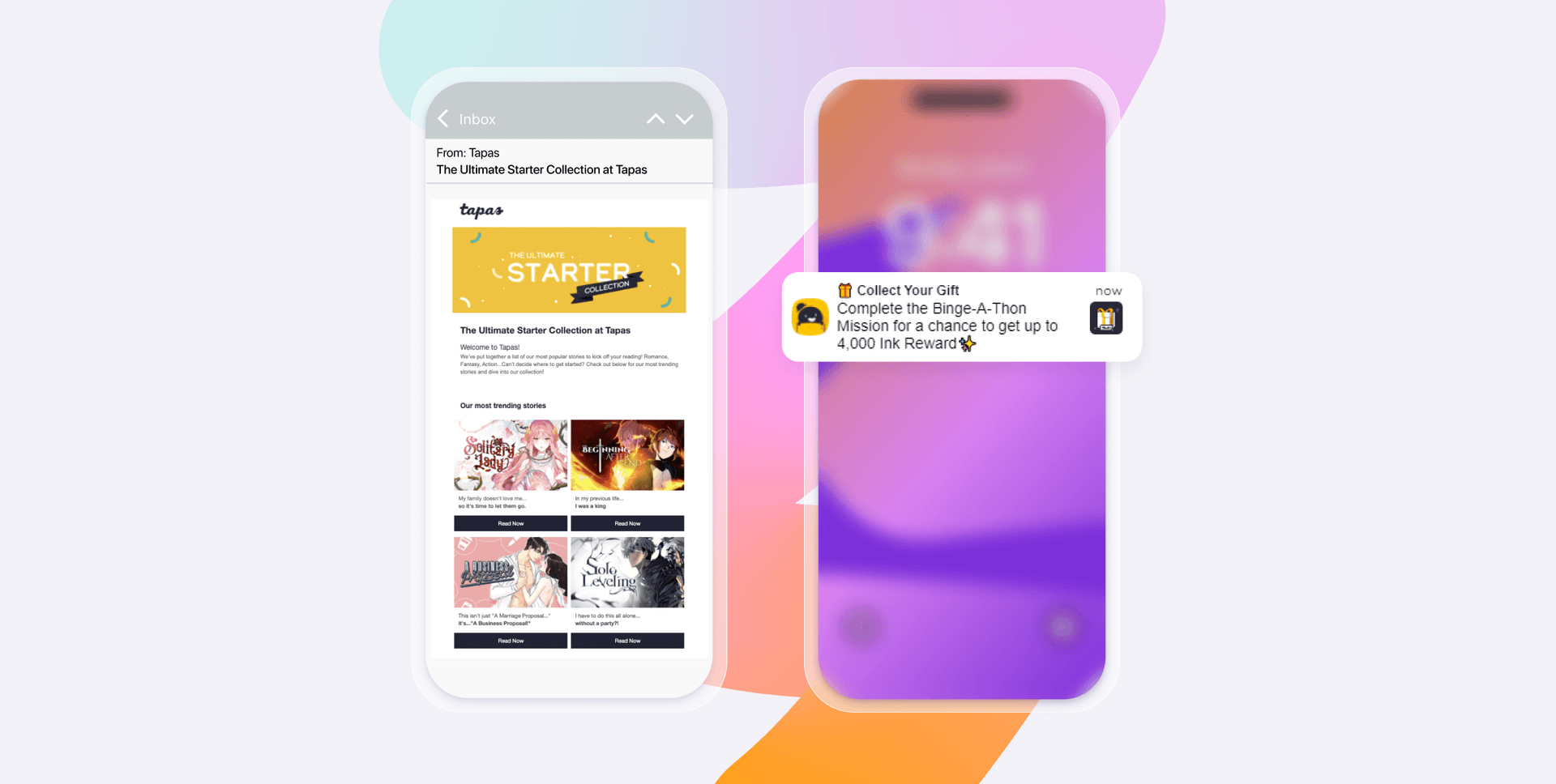
These efforts have helped Tapas enhance their onboarding process, which in turn has enabled the brand to double its retention rate as well as generate gains in purchases and engagement rates.
Results:
- 100% Increase in New User Retention
- 28% Increase in “Ink” Purchases
- 10% Increase in Episode Read Funnel
5. Coffee Club streamlined customer engagement to drive a 35% increase in loyalty member sales
Australia’s largest café franchise, The Coffee Club, knew that growing its loyalty program would be key to bringing more customers into their stores, particularly among younger customers. The problem? They had too many disconnected platforms and not enough clear insights into their customers’ cross-channel experience. Another downside: They knew they needed to improve their app ratings to get more downloads.
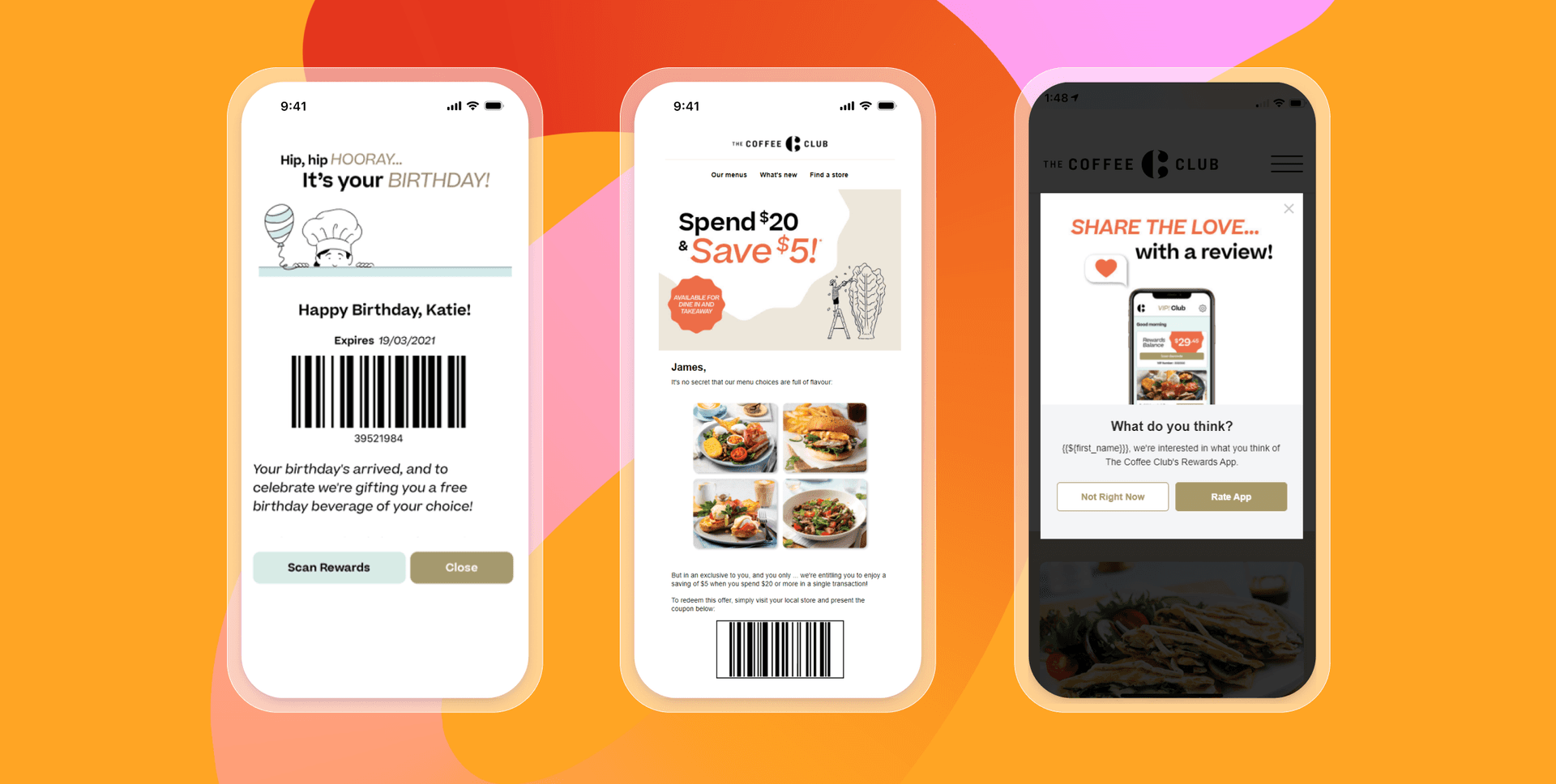
To increase The Coffee Club’s loyalty program participation, the company teamed up with Braze to use Content Cards to send personalized offers based on customers’ unique attributes and purchase events, using barcoded coupons that work seamlessly with point-of-sales systems in stores. They also leveraged Braze to target and send in-app messages and emails to regular app users who were happy with the latest version of their app, inviting these customers to leave a rating in their mobile device’s app store.
As a result of both of these efforts, The Coffee Club saw loyalty member sales jump by 35% and app ratings soar from 2.4 to 4.1.
Results:
- 35% Increase in Loyalty Member Sales
- 4.1 App Store Rating Achieved in 2 Weeks
4 tips for creating a best-in-class customer retention marketing strategy
Use these four strategies to bolster customer engagement and user lifetimes, right from day one and throughout a customer’s journey with your brand.
1. Onboard newly acquired customers the right way
A new customer's first experience with a brand plays a significant role in retention. Effective onboarding is critical to ensuring an optimal initial touchpoint. That means educating customers about the value of your products or services and how they can best take advantage of these benefits right away. This thoughtful approach will lead to greater engagement right away and over time.
2. Personalize your marketing outreach
Collecting the right zero-party data and first-party data about who your users are—and what their needs, interests, wants, and behaviors are—at the 1:1 level will empower your brand to create more relevant and meaningful experiences that keep customers coming back for more.
That’s a strategy that HBO Max LATAM has employed, using in-app message surveys to gather customer insights to then tailor experiences for users, resulting in an impressive 15% uplift in engagement and churn prevention.
3. Use A/B and multivariate testing
Through experimentation, marketers can not only improve individual campaign performance, but the overall health of their customer engagement efforts, driving stronger retention over time. By analyzing A/B and multivariate tests, marketers can pinpoint which efforts are increasing retention, insights that can be used to double down on effective retention tactics moving forward.
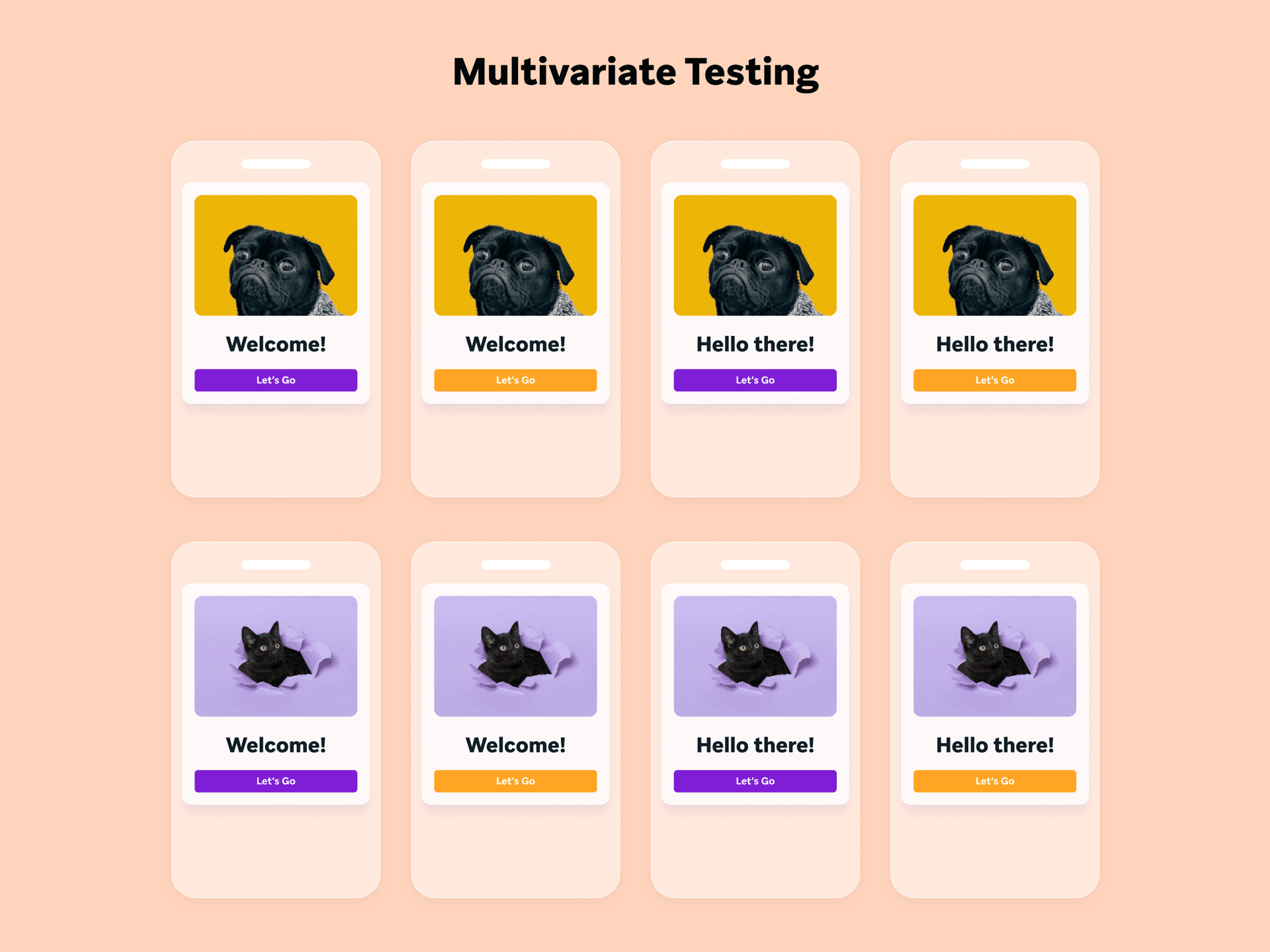
4. Intervene when customers show early signs of churn
Customers who no longer open push notifications or emails as often as they once did, regularly abandon their shopping carts or let long periods of time pass between visiting a company’s app or website are disengaging and may be on the verge of churning altogether. After they’ve uninstalled a brand’s app, unsubscribed from the company’s emails, and opted out of receiving push notifications, they may already be gone. Brands can intervene as soon as customers indicate lower levels of engagement by:
- Conducting testing
- Asking customers about their preferences
- Soliciting customer feedback to see what’s working (and not)
- Improving personalization efforts and acting on customer feedback
4 ways customer engagement platforms support client retention marketing
Customer engagement platforms like Braze are designed to help marketers strengthen their customer retention marketing initiatives. Here are must-have features that are built into Braze that empower brands to foster longer user lifetimes.
1. Cross-channel customer engagement capabilities
Given the influence of cross-channel customer engagement on customer retention—Combing in-product and out-of-product channels results in a 61% uplift in 90-day retention compared to out-of-product channels alone—cross-channel messaging is a key capability marketers need to be able to do their jobs effectively.
The Braze platform makes it easy to launch channels with support for SMS, email, push, in-app and in-browser messaging, and more, with our drag-and-drop journey orchestration tool, Canvas.
2. Predictive churn analytics
The Braze customer engagement platform lets your team define what churn means for your business and uses machine learning to create a predictive model that’s designed to identify users at risk of churn by paying attention to the actions taken by both users who do not end up churning and those who do over time.
This predictive model assigns a churn risk to each user on a score of 0 to 100, the higher the number indicating a higher likelihood of turnover. This allows marketers to reach out to customers at a higher risk of churn (those with higher scores) with more targeted campaigns to attempt to prevent turnover in the first place.
3. Personalization features
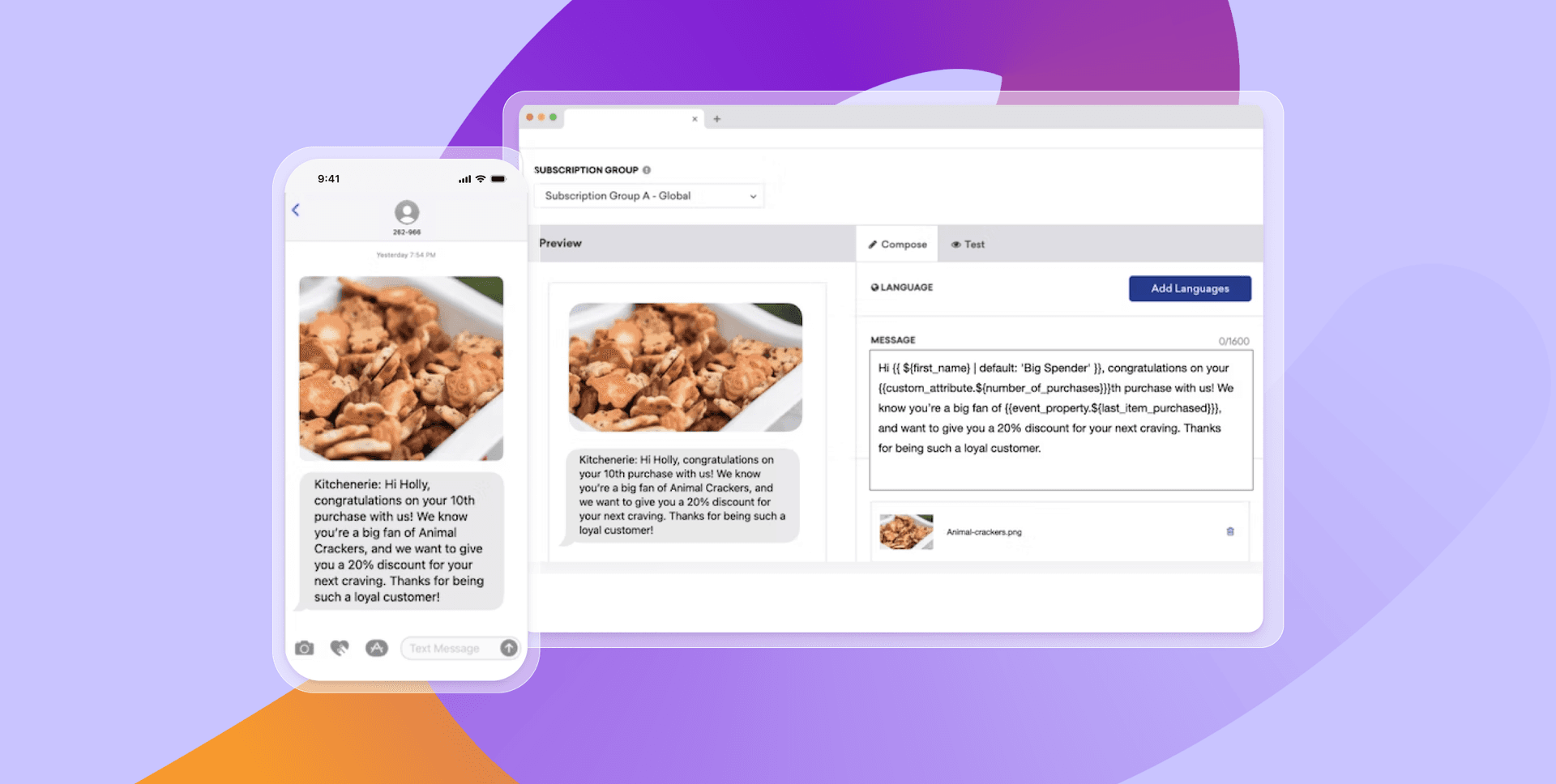
Braze offers a range of personalization functions that enable marketers to send more effective, tailored marketing outreach that gets more users to continuously engage, including:
- Braze AI Item Recommendations: This BrazeAI™ feature is designed for brands to surface the next best product, content, or items that are personalized to every customer at scale. Easily plug intelligent recommendations into campaigns on any channel to help customers find more value from your brand.
- Braze Action Paths: This solution triggers the right user experience for each customer at the next moment in the customer journey based on the actions they’ve just taken using customer journey orchestration
- Connected Content: This real-time personalization tool makes it possible for brands to deliver dynamically updating emails, push notifications, in-app messages, and more in-the-moment messaging campaigns that are personalized to a unique user’s location and preferences
- Liquid personalization: A core feature included with Braze’s customer journey builder, Liquid templating allows brands to personalize campaigns based on a user’s country, gender, loyalty tier, and actions they’ve taken
4. Testing tools
Braze offers the best in testing tools, including A/B and multivariate testing, to make it easy for brands to evaluate the impact of a single variable or multiple variables on customer engagement with a given campaign as well as on overall retention over time.
For example, Braze Personalized Variant—a personalized testing feature—that lets brands send users the best variant for each individual’s preferences and behaviors, instead of the “winning variant” from A/B or multivariate tests.
Final thoughts
Some customer turnover is natural, to be expected, and, frankly, can’t be avoided. That’s why harnessing zero- and first-party data to more effectively understand and meet the needs of consumers and using these insights to better activate, engage, and retain customers throughout their lifetimes—however long those lifetimes may be—is a competitive advantage, and it’s an approach savvy marketers like you can use to build stronger relationships with your customers and be seen as the provider of choice in your category.
Customer retention marketing FAQs
What are the key factors of customer retention?
There are four effective ways to increase user retention: (1) increase the intensity of customers’ use of a given product or service (i.e. increase how much time or money they spend each time), (2) expand upon the use cases for customers to engage with your brand, (3) increase the number of features customers use (i.e. boost the percentage of features each user takes advantage of out of your brand’s total offerings), and (4) increase the frequency with which a customer uses your brand’s products or services.
What is the retention stage in digital marketing?
The retention stage in digital marketing refers to the phase where businesses focus on keeping existing customers engaged and satisfied after their initial purchase or interaction with the brand. This stage is important because retaining customers is often more cost-effective than acquiring new ones, and loyal customers can contribute to a brand's long-term success.
How can a marketer measure customer retention?
Retention can be measured by tallying up all of the people who initially engage with your brand and then keeping track of those that stick around—or are retained—over time. Here's one common formula for determining customer retention:

Keep in mind that customer retention may be defined differently depending on your business objectives. Check out this resource to learn more about the top ways to calculate user retention.
What are the KPIs for customer retention?
Customer retention KPIs help businesses measure the effectiveness of their retention strategies and understand customer loyalty. Here are some examples:
- 30-day retention
- 90-day retention
- 120-day retention
- Customer retention rate
- Churn rate
- Customer lifetime value (CLV)
- Repeat purchase rate
What is customer retention rate?
As the name indicates, customer retention rate is a measure of the rate or percent of customers who are retained over time. That is, of all the customers a brand has acquired, customer retention rate represents the portion of users who stick around. Let’s say a brand acquires 500 new users within the first month of launching, but by the second month, only 250 are still active, the company would have a 50% customer retention rate and a 50% turnover or churn rate.
What is a realistic customer retention rate?
“Normal” or “realistic” customer retention rates vary widely by industry, company, type of product, etc. It’s important to figure out and measure against your own benchmarks for accuracy and success. However, it’s also useful to have a pulse on your industry.
Here are retention benchmarks for three industries, according to our partner Amplitude:
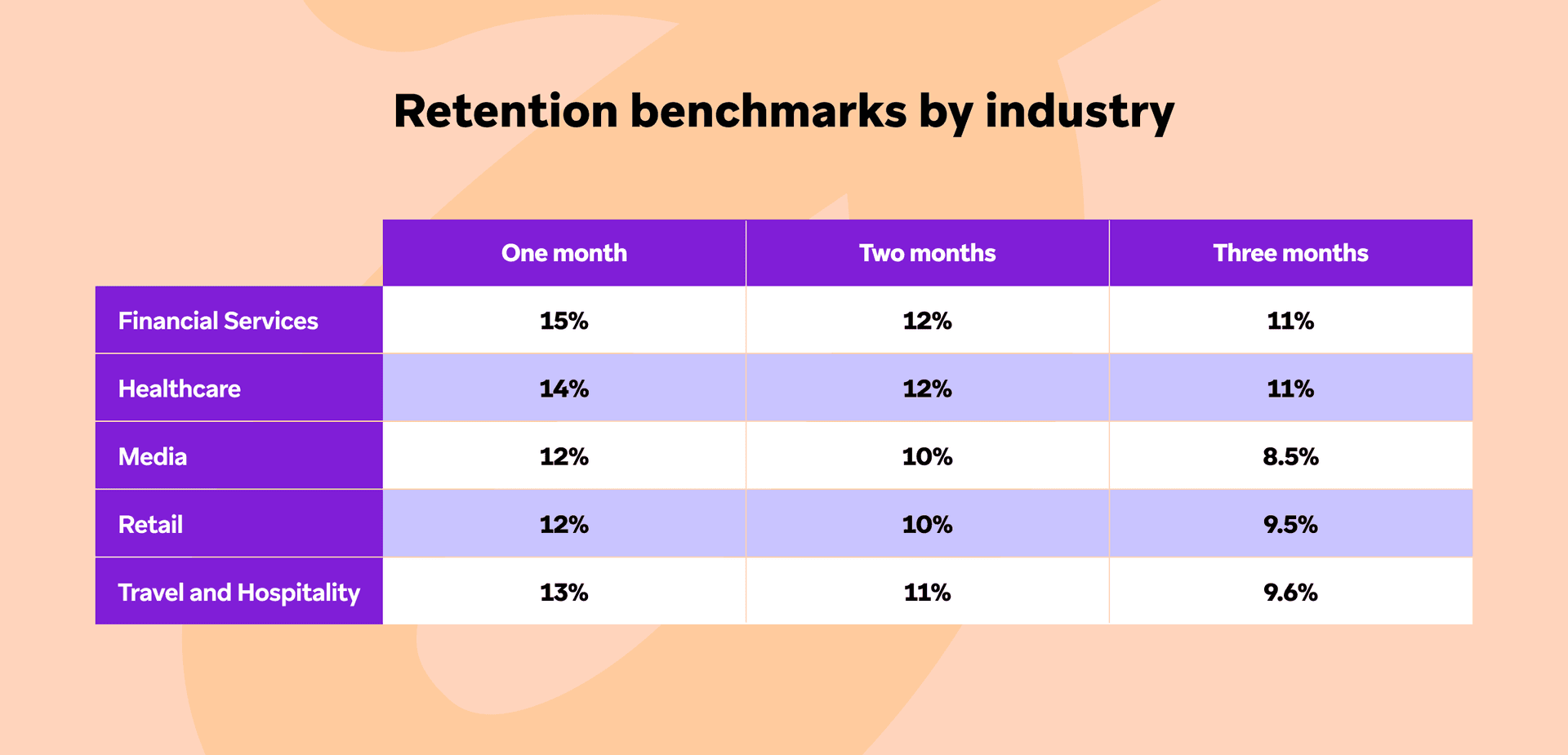
What is customer churn?
Churned customers are customers who are not successfully retained. Customer churn is also known as customer turnover. It is one of the most important metrics for businesses to keep track of and minimize to keep costs in check.
Brands can calculate their churn rate by subtracting their retention rate from one. In other words, one minus retention rate equals a company’s churn rate.
What’s the difference between customer retention marketing and customer acquisition?
Customer acquisition and retention are both important components of a comprehensive growth strategy. Acquisition is all about attracting new customers while retention focuses on them coming back and sticking around.
The best companies know how to strike a balance between the two. They attract new customers while also keeping their existing ones loyal and engaged.
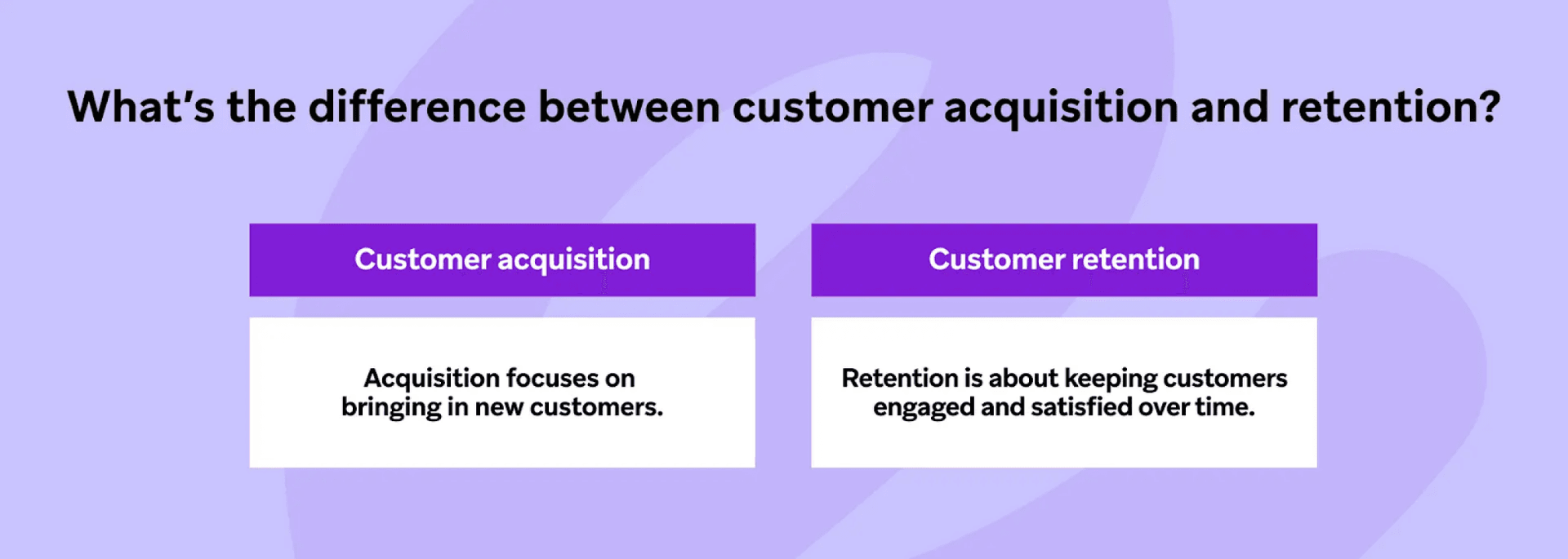
Forward-Looking Statements
This blog post contains “forward-looking statements” within the meaning of the “safe harbor” provisions of the Private Securities Litigation Reform Act of 1995, including but not limited to, statements regarding the performance of and expected benefits from Braze and its products and features. These forward-looking statements are based on the current assumptions, expectations and beliefs of Braze, and are subject to substantial risks, uncertainties and changes in circumstances that may cause actual results, performance or achievements to be materially different from any future results, performance or achievements expressed or implied by the forward-looking statements. Further information on potential factors that could affect Braze results are included in the Braze Annual Report on Form 10-K for the fiscal quarter ended January 31, 2025, filed with the U.S. Securities and Exchange Commission on March 31, 2025, and the other public filings of Braze with the U.S. Securities and Exchange Commission. The forward-looking statements included in this blog post represent the views of Braze only as of the date of this blog post, and Braze assumes no obligation, and does not intend to update these forward-looking statements, except as required by law.
Related Tags
Be Absolutely Engaging.™
Sign up for regular updates from Braze.
Related Content
View the Blog
The new inbox reality: How iOS changes are reshaping email marketing

Aparna Prasad

Experience optimization: Turning data insights into better journeys

Team Braze

December 2025 Bonfire Marketer of the Month: Jagex’s Emma Oliver
